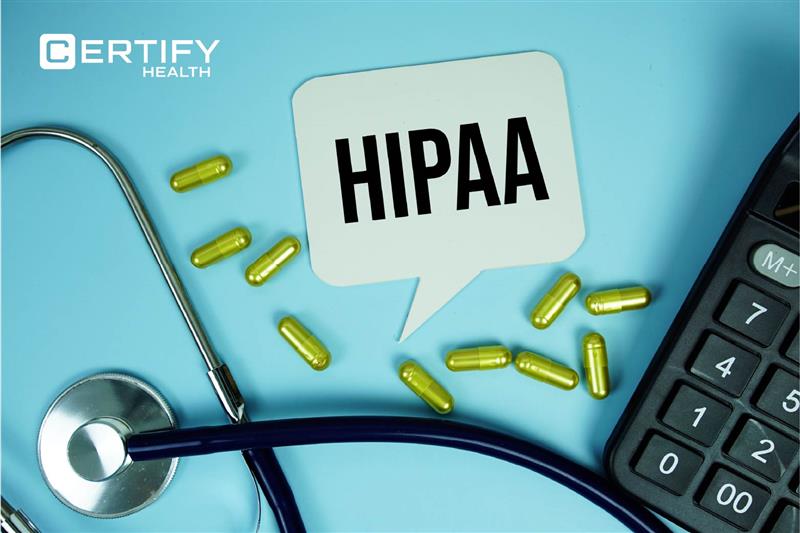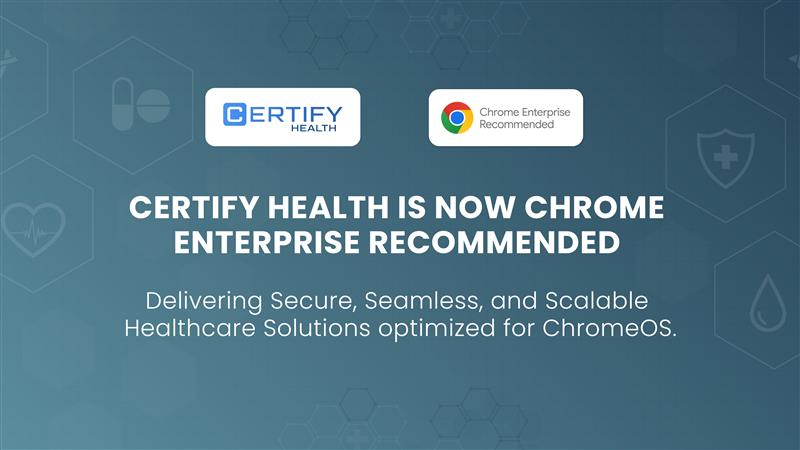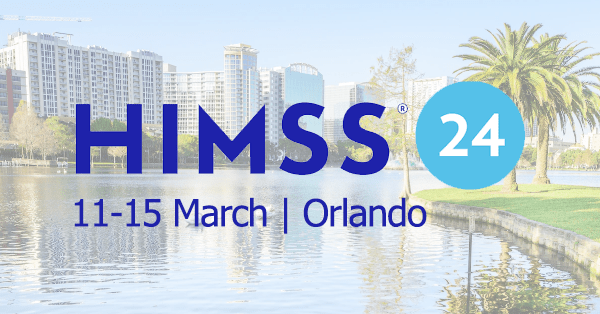Revenue cycle management is the backbone of the healthcare sector, yet it continues to face significant challenges like manual inefficiencies, staff shortages, claim denials, and complex compliance requirements. Overcoming these hurdles is essential to ensuring a stable cash flow for healthcare practices.
A survey of 200 healthcare providers revealed that 40% lost up to half a million dollars annually due to claim rejections. This highlights the need to improve revenue cycle efficiency.
What is Revenue Cycle Management?
Revenue Cycle Management (RCM) is the financial backbone for healthcare practices, it involves the entire patient journey from scheduling to registration, patient intake to insurance verification, and payment collection.
This critical system not only manages front-desk tasks but also connects with clinical operations, where your practice will ensure that accurate handling of patient transactions for a smoother experience.
The Healthcare Financial Management Association (HFMA) explains this RCM in an easy way that it is a comprehensive cycle including all administrative and clinical functions essential for capturing, managing, and collecting patient service revenue.
Here are some key major components of RCM:
- Charge Capture
- Claim Submission
- Coding
- Patient Collections
- Preregistration
- Registration
- Remittance Processing
- Third-party Follow-up
- Utilization Review
So, you might have got an idea what is Revenue Cycle Management. Now, let us dive into the building blocks of healthy revenue cycle

Building Blocks of a Healthy Revenue Cycle
Revenue Cycle Management is all about ensuring providers that they are getting paid completely or reimbursed for the care they provide to patients. The true ROI extends far beyond numbers involving streamlined billing, claims, and payment collections to drive better care, happier patients, engaged staff, and financial stability.
Based on this benefit, revenue cycle process is built on three needs:
- Efficiency – Streamlining processes throughout the billing cycle to eliminate unwanted resource utilization
- Accuracy – Reducing claim denials and payment delays by verifying insurance coverage at an earlier stage.
- Transparency – Give patients and providers timely payment information, enabling informed decisions during every transaction.
To achieve revenue cycle efficiency, providers are switching from slow, costly manual systems to digital RCM tools, which are truly helpful.
In addition to this, healthcare setting needs some revenue cycle management strategies to optimize the process. Let’s learn these strategies in depth:
Did you know?
Insurance reimbursement rates are the amounts paid by insurers to healthcare providers for services rendered. It may vary by service type, a study revealed that private insurers pay 143% of Medicare rates for professional services, 205% for inpatient care, and 263% for outpatient care. The insurance reimbursement rates impact healthcare costs, provider earnings, and patient affordability, influencing overall access to quality medical services.
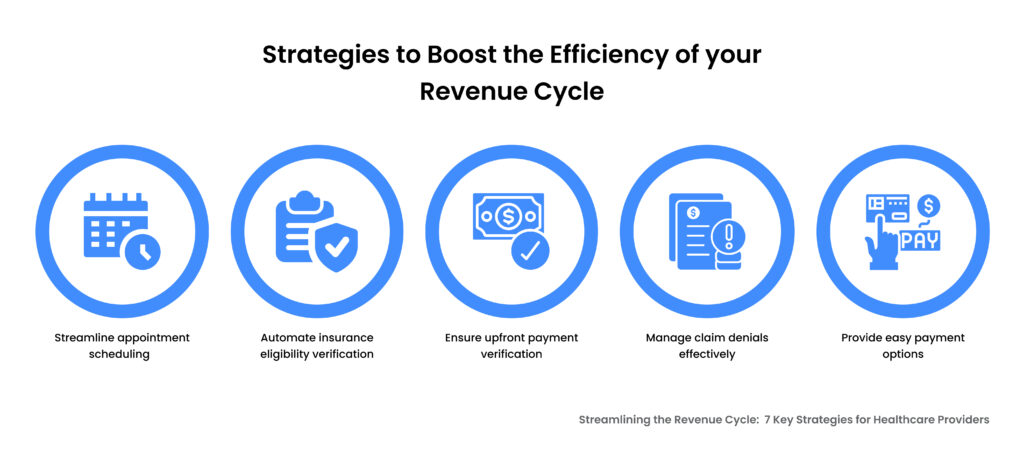
Revenue Cycle Management Strategies for Your Practice
You can optimize your revenue cycle management by streamlining your patient journey using RCM solutions like CERTIFY Health, which simplifies your entire patient journey from patient scheduling to insurance verification, billing, and payment collections. Whether you operate a small practice or a larger healthcare organization, the strategies can be implemented easily, and you can see their impact on your revenue cycle.
1. Increase Efficiency in Patient Access
The very first step of revenue cycle management starts when the patient schedules their appointment with your practice. Any patient data errors occurring in the scheduling and pre-registration stages can directly cause delayed payments and claim denials.
With efficient, data-driven patient access solutions like 24/7 self-scheduling option, providers can simplify administrative tasks and improve accessibility. This enables patients access to the next stage in the care journey involving a little friction. Furthermore, less errors in the initial stages will reduce payment collection delays and ensure quick resolution of payment issues.
Automated registration and self-scheduling help your practice save the hard costs through efficient staff usage along with eliminating no-shows. CERTIFY Health’s patient scheduling software offers Patient Access to online scheduling, allowing patients to book appointments at their convenience, reducing missed appointments while elevating revenue.
Though ensuring efficient patient access through automated registration and scheduling is crucial, checking your patient’s insurance eligibility is another challenge to optimize RCM.
2. Automate Patient Eligibility Verification
Automating Patient Eligibility Verification is important for optimizing RCM in healthcare. With error-prone manual insurance verification, your practice can face delayed payments and denied claims.
With CERTIFY Health’s insurance verification software, your practice can capture and verify patient insurance information in real time. This reduces claim denials, as it auto-validates the patient’s insurance information. The software also gives a detailed overview of the patient’s co-pay and deductibles, ensuring easy collection and claims submission. Not only that, but the software also complies with HIPAA compliance and reduces the risk of data security.
Did you know?
According to a study by McKinsey & Company , automation can reduce billing errors by up to 90%, which directly improves Account Receivable (AR) Turnover Rate. Fewer billing mistakes mean quicker payments, reducing delays and boosting the rate at which practices collect payments. This leads to better financial efficiency and healthier cash flow.
With automation, your practice can improve patient satisfaction and help your staff get real-time updates about any coverage or data changes. You can reduce billing errors and avoid surprise billing with accurate eligibility verification. This is one of those revenue cycle management strategy not only saves your time but also enhances the patient’s experience.
Automated insurance eligibility verification tools ensure accurate and timely billing, reducing errors and speeding up payment collections.
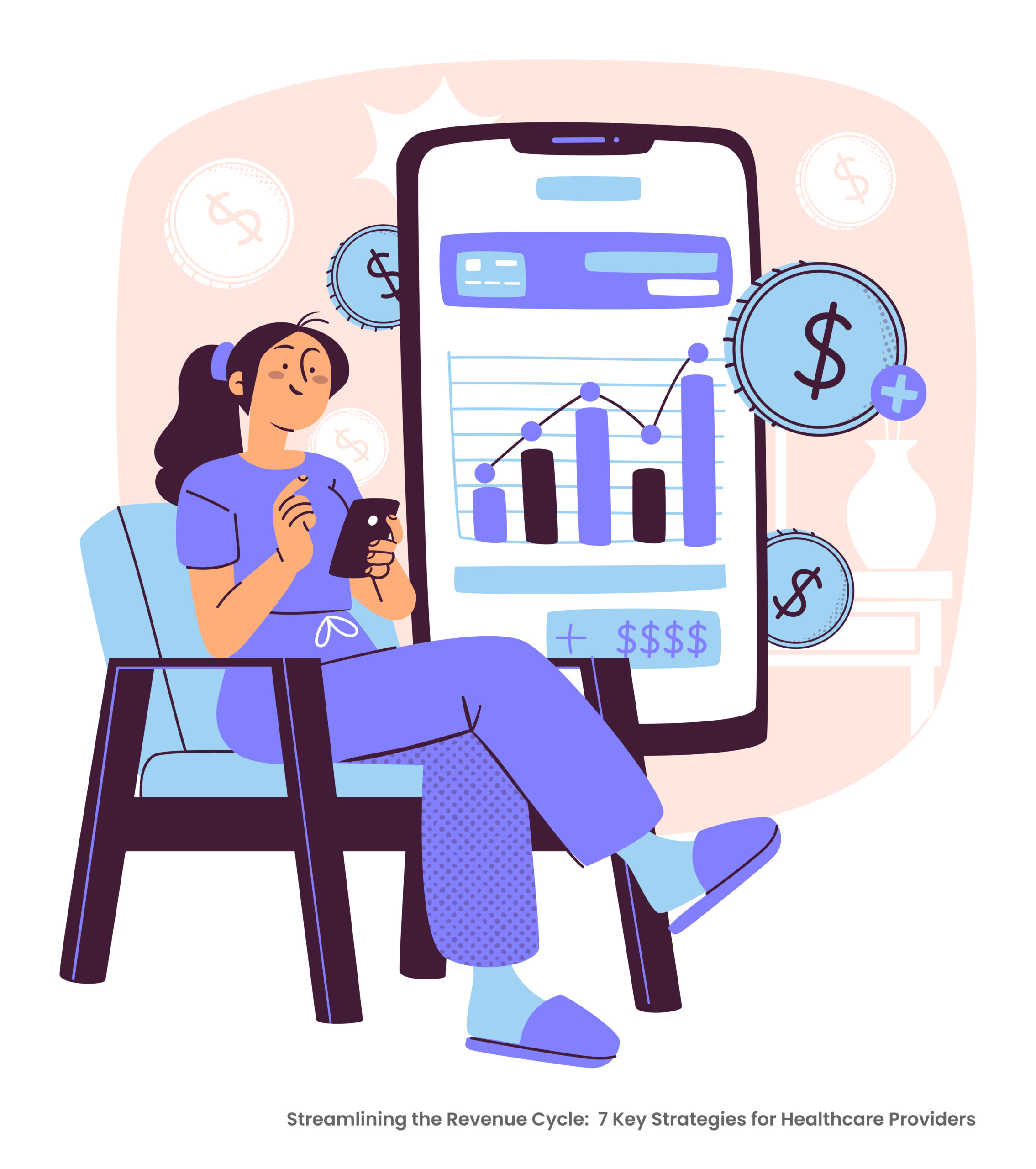
3. Deliver accurate and timely patient billing
Patients today expect a smooth, transparent billing process. Surveys consistently show that a lack of clear and accurate billing leads to frustration and impacts overall satisfaction.
Did you know?
After doing multiple surveys, a healthcare platform has found that patients are worried about their treatment costs. Also, 63% of providers noticed that patients delay getting care because of treatment costs.
By automating billing workflows, your practice can deliver precise invoices promptly, ensuring patients know exactly what they owe and why. Automated billing systems minimize errors, reduce follow-up inquiries, and enable faster payment collections.
Automated patient billing offers several key benefits, including no surprise billing (providing clarity and transparency through detailed invoices) that boost patients’ trust and satisfaction. It ensures faster collections by reducing payment delays and accelerating cash flow, while also enhancing the patient’s experience with straightforward payment processes that minimize confusion and eliminate surprise billing.
Accurate billing lays the foundation for an efficient and patient-centered revenue cycle, when it is paired with offering transparent price estimates to patients.
4. Provide Transparent Price Estimates
Most patients struggle to settle their large outstanding balances because of unexpected medical costs. Providing your patients with transparent estimates relevant to their care is crucial in optimizing revenue cycle efficiency.Did you know?
A healthcare platform’s Patient Access Report reveals that three in ten patients only understand their treatment costs in advance. This clearly indicates the need to provide transparent price estimates to your patients.
5. Easy Ways to Pay Bills
How easy is it for your patients to pay their bills? While it may seem like a simple question, it carries significant weight in the success of your revenue cycle management (RCM). Creating streamlined patient payment experience is very important in RCM to improve payment collection and maintain cash-flow.Did you know?
Based on J.P. Morgan payment trends, it reveals the fact that 71% of providers still collect payments from patients using paper-based manual methods. But 75% of patients want to pay bills online using Credit cards, mobile wallet like Apple Pay/Google Pay, and more.
This gap highlights the urgent need for healthcare practices to adopt digital solutions for easy patient payment collections. By offering modern, flexible payment options, you can meet patients where they are, reduce administrative burdens, and improve cash flow—all while enhancing the patient’s experience.
CERTIFY Health’s patient payment management platform help practices to meet their financial goals with ease and confidence. For instance, our platform’s text-to-pay option enables you to receive payments just in minutes soon after sending a text message to patients.
6. Manage Claim Denials
Managing claim denials is important to optimize revenue cycle management. It starts with identifying the root causes and analyzing denial patterns to uncover recurring issues. Most claim denials arise from preventable errors such as coding inaccuracies, missing patient information, or incorrect data entry.
Did you know?
According to an American Academy of Family Physicians (AAFP) report, the average claim denial rate across the healthcare industry is between 5% to 10%. However, practices relying heavily on manual processes often face significantly higher denial rates, creating a substantial impact on their revenue cycle.
By implementing automated RCM tools and robust workflows, your practice can minimize errors, ensure accurate data capture, and streamline claims processing. Also, practices can proactively address denial trends through regular audits and staff training. It will further reduce rejection rates, improve claim approvals, and accelerate reimbursements.
This approach not only strengthens your financial performance but also enhances operational efficiency and patient satisfaction. In addition to managing claim denials, let your practice improve RCM using KPIs.
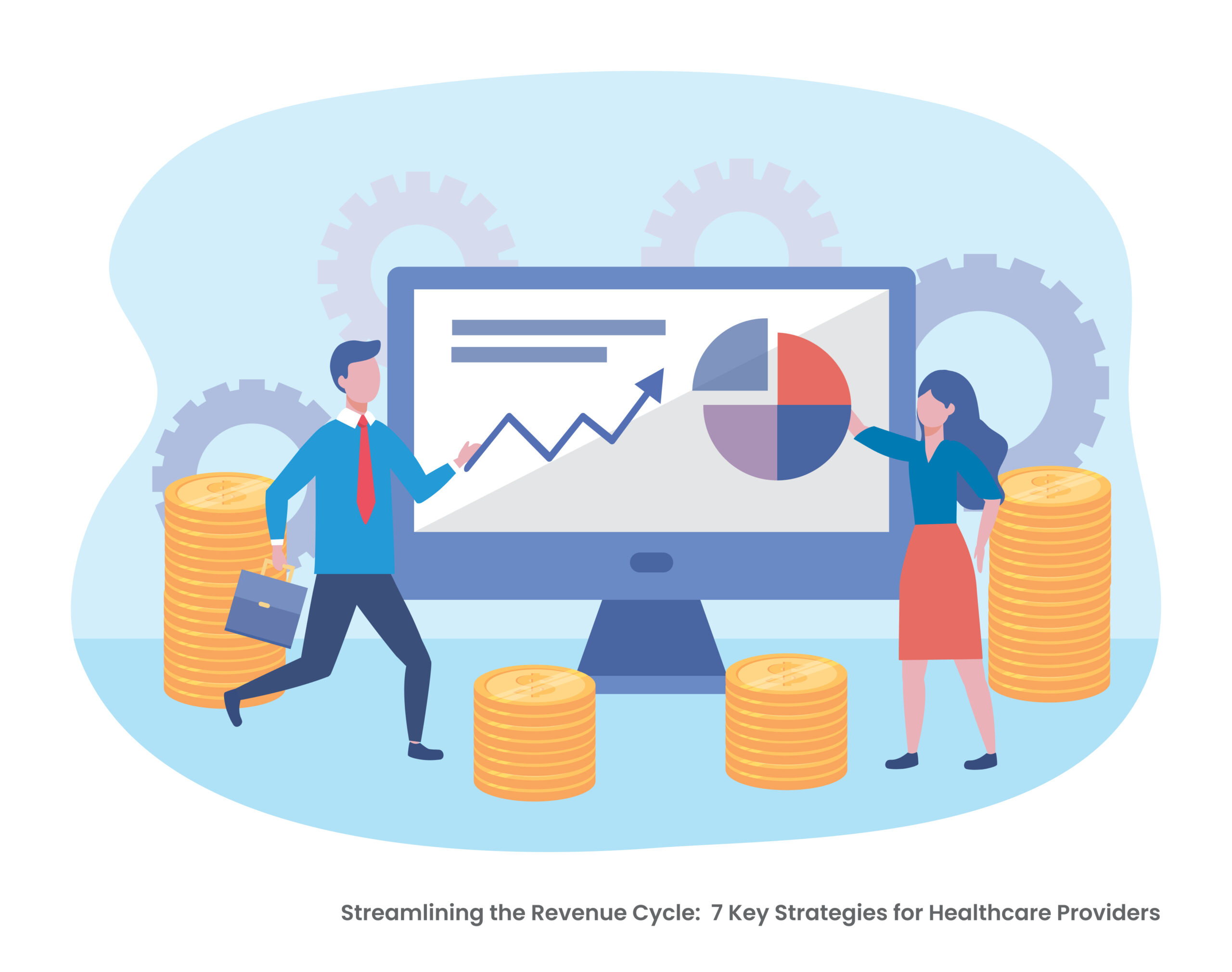
7. Improve Revenue Cycle Management with KPIs
Effective revenue cycle management is the backbone of a successful healthcare practice, and Key Performance Indicators (KPIs) play a pivotal role in optimizing this process. Metrics like days in accounts receivable, claim denial rates, and collection rates provide actionable insights into your practice’s financial health, helping to pinpoint strengths and areas for improvement.
At CERTIFY Health, we understand the value of regularly benchmarking your KPIs against industry standards to assess performance and uncover inefficiencies. For instance, high days in accounts receivable might signal billing delays that need immediate attention to boost cash flow and reduce operational strain.
Leveraging advanced data analytics, our solutions enhance KPI tracking by identifying patterns and recurring issues, enabling targeted interventions. Spotting spikes in claim denials can drive corrective actions, while forecasting revenue trends supports strategic resource planning to keep your practice ahead.
Implementing changes informed by KPI insights—whether it’s staff training to reduce coding errors, streamlining patient payment options, or automating key processes, will help your practice refining your revenue cycle through data-driven strategies. Thus, you can achieve operational excellence, improve patient satisfaction, and ensure long-term financial success.
CERTIFY Health - Effective Revenue Cycle Management Solution
From labor shortages to rising costs, healthcare providers are navigating challenges with innovative approaches to managing cash flow. While every healthcare organization has unique needs and goals, mastering these seven key strategies for effective revenue cycle management can help hospitals optimize processes, improve efficiency, and adapt to new uncertainties with confidence.
CERTIFY Health is here to support your success. Our advanced automation and patient payment solutions are designed to transform your revenue cycle by streamlining workflows, reducing inefficiencies, and driving measurable improvements.
Ready to elevate your Revenue Cycle? Let’s connect to discuss how CERTIFY Health can help your practice thrive.
FAQs:
What is RCM in Healthcare?
What Are the Issues Faced in Revenue Cycle Management in Healthcare?
What Strategies can Enhance the Efficiency of the Revenue Cycle?
To increase your revenue cycle efficiency, you can follow the given below strategies:
- Streamline appointment scheduling processes
- Automate patient eligibility verification
- Ensure upfront payment verification
- Modernize claims processing approach
- Outsource medical billing tasks
- Effectively manage claim denials
- Track and follow up on claims



